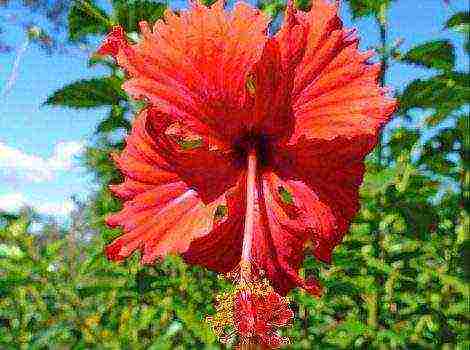Content [show]
Garlic is a herbaceous perennial. It is a popular vegetable crop. Central Asia is considered the birthplace of garlic, but now it is cultivated all over the world. Garlic is prized for its ability to strengthen the immune system, improve digestion, and stimulate appetite. This vegetable can be planted in spring and fall. It all depends on the species. Let's talk today about winter garlic, about planting and care in the open field. Let's talk about the most popular varieties of winter garlic.
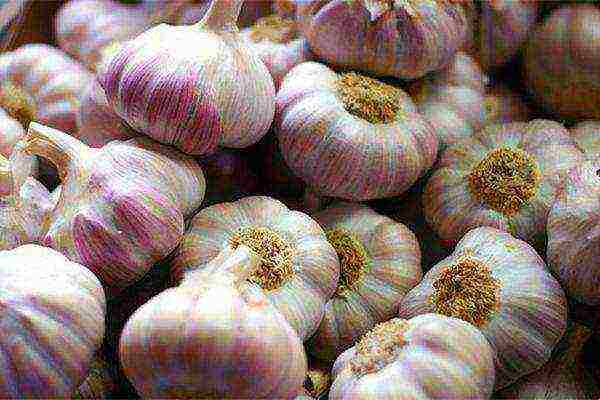
Garlic: a description of the culture
Garlic has a fibrous root system, the bulb is rounded, complex, which forms many children in the sinuses, which are called cloves or cloves. They are covered with dark purple, white or yellowish scales.The leaves of garlic are lanceolate, narrow, erect, more than 30 cm long. The peduncle reaches a height of up to 150 cm, arrows with inflorescences are formed at its end. There are spring and winter garlic depending on the planting time. Distinguish between winter shooters and winter non-shooters types of garlic. This type of garlic is planted in crops before winter.
Winter garlic varieties
Winter garlic is poorly stored, so it is more often used for cooking. But it is distinguished by early ripening, rich harvest with large bulbs and cloves. The most popular varieties:
- Petrovsky. High-yielding shooting variety of winter garlic. It has a pungent taste and firm flesh. The variety is resistant to disease.
- Jubilee Gribovsky. Medium late shooter grade. It is disease resistant. The taste of this garlic is pungent. The heads are large, with a lilac husk, each bulb has 10-12 cloves.
- Boguslavsky. Cold-resistant variety. Ripening heads are small, they have only 6 cloves, lilac-gray scales.
- Losevsky. Shooting winter-hardy variety with high yields. The bulbs are round-flat, weighing up to 80 grams. It can be stored for six months.
- Komsomolets. Arrow variety, mid-season, cold-resistant. The dense head is covered with a pinkish husk, it contains from 6 to 13 teeth of winter garlic.
- Gulliver. Shooting variety, medium late. Heads with dark gray scales, pungent taste, white flesh. Head weight up to 120 grams. Refers to varieties with a long shelf life (up to 8 months).
- Gribovsky 60. The variety is early ripening, with a sharp taste. It is weather resistant. Each head has up to 11 teeth.
- Jubilee 07. Mid-season high-yielding variety. Harvest - round-flat white heads. Head weight up to 80 grams.
- Flight. Cold-resistant variety. Small heads, cloves in bulbs from 6 to 8.

The following varieties of garlic are often used: Sakskiy, Donetskiy violet, Parus, Lyubasha, Kharkovskiy violet and others.
Growing winter garlic
Planting of winter garlic is carried out in the fall. It is necessary to comply with the terms and scheme of planting. The timing depends on the climate and geography of the place where the garlic will be grown. You can be guided by the lunar calendar, you can use your own experience, but the planting of winter garlic should be done before the first frost. And not in one day, but at least three to four weeks. This is imperative for the garlic to take root well. A hardened root system will prevent garlic from dying. It is too early to plant garlic, because then, before the cold snap, it will have time to sprout, which will freeze, this will destroy the culture.
You can't just plant garlic anywhere in your backyard. You need to choose the right place, prepare the soil, take into account the predecessors of garlic. Only if the growing conditions are observed, a number of activities are performed, can a good result be achieved.
Where to make a garden
The garlic area should be very sunny. It is worth giving preference to a hill over a lowland, since moisture will accumulate there, and although garlic loves watering, it is unlikely to tolerate stagnation of water. It is necessary to take into account the cultures that grew before this. The most suitable crops are squash, cabbage, peas or pumpkin. Garlic grows well after green manure crops (clover, alfalfa). But tomatoes, carrots and cucumbers are best avoided. Onions and garlic can also be attributed to the worst predecessors.
Garlic grows well next to berry crops: raspberries, gooseberries, raspberries. If you plant garlic next to strawberry bushes or in the same bed with them, it will grow well, will not hurt, and will delight you with the harvest. Good neighborhood of garlic with flower crops. These are tulips, gladioli, roses. Garlic will scare away caterpillars and slugs from these flowers.
How to prepare the soil
The soil in the garden must be prepared in August.It is carefully dug up, the plants that grew in the garden along with the roots, weeds are removed. When planting, fertilizers are applied to the soil. Potassium salt mixed with superphosphate and humus feeds well any soil. The soil is leveled with a rake, the bed is covered with a film, in this form it will wait for the day of planting.
How to process planting material
Winter garlic can be planted in bulbs and cloves. The yield of the variety depends on how high-quality the planting material is. It all starts with the preparation of the seed. The teeth are sorted out, the damaged ones are immediately removed. The cloves should lie in the refrigerator for a couple of weeks before planting. Then they are sorted by size. Selected specimens must be disinfected by flooding with potassium permanganate solution for a couple of hours. Ash solution can be used. Pour 200 grams of ash with a liter of water and boil for half an hour. Cool and place cloves in it for two hours.
Planting winter garlic
Prepared large cloves are embedded in holes to a depth of 12-15 cm. If planting is carried out with bulbs, grounding is carried out to a shallower depth. The planted seeds are sprinkled with earth, on top with a layer of peat. Sawdust mulching is carried out. This will help protect the garlic from frost. As soon as frost hits and snow falls, it is necessary to make sure that it lies flat on the beds, creating a snow cover. It will help withstand any frost.
Garlic care
In the spring, when the snow melts, the first shoots will appear. It is necessary to care for garlic in the open field: weeding, watering, feeding, fertilizing the garlic. Watering should correspond to weather conditions, it should be regular, but without stagnant moisture. Three times a season, you need to fertilize the planting with fertilizers of different composition. Top dressing should be nitrogen fertilizers, urea or mullein.
Diseases and pests can overtake winter garlic. This is powdery mildew, stem nematode, gray rot. To prevent infection from occurring, you need to be careful about the planting material and the landing site.

Harvesting and storage
Harvesting begins in early August. Signs of harvest time are:
- yellowed old leaves;
- formed heads with a characteristic color;
- cessation of the formation of new leaves.
Cleaning of garlic from the beds takes place on a dry day. They dig in the garlic, pull it out of the ground, freeing it from the ground. You can spread the garlic right in the garden. The garlic is kept for about 10 days, then the leaves and roots are cut off. Winter garlic should be stored at 2-4 ° C. It is prone to rot, so it cannot be stored for too long.
You can braid the garlic into braids. For this, the stem is not cut, but only the leaves are removed. These braids can be hung under the roof of an attic or shed. You can store garlic in wooden boxes, sprinkle with salt. From time to time it is necessary to sort out, some heads may deteriorate.
Planting garlic outdoors
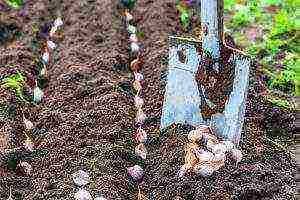
Garlic is a hot spice that is actively used in cooking and traditional medicine.
Growing and caring for garlic in the open field on their own gives gardeners the opportunity to get maximum benefit from it without harm to health, which the purchased one can bring.
Meanwhile, it is quite easy to grow a culture at home if you know and follow the basic rules of planting and caring for a plant.
Before starting the cultivation procedure, it is recommended that you familiarize yourself with the basic rules and recommendations:
- Garlic beds are best chosen in places well-lit by the sun.
- Avoid planting a crop in a low-lying area. In such conditions, the accumulation of liquid is possible, which will have a detrimental effect on the condition of the plants.
- It is important to add natural or synthetic fertilizer to the soil before planting.
- It is recommended to mulch over the winter bed and cover it with brushwood to delay the snow masses.
- The sowing depth directly depends on the size of the seed.The largest varieties should be deepened by eight to nine centimeters, the smallest ones by six to seven.
- Only large seeds should be chosen for planting. Separate them from each other carefully. You do not need to peel the cloves.
- Do not sow into freshly dug soil, otherwise the tines will be deeper than necessary. Prepare the soil no earlier than a week in advance.
- The sowing site should be changed regularly (at least once every two years). You can use the same ridge only with an interval of four years.
The correct approach to growing crops will allow you to grow a high-quality and rich harvest, and also significantly reduce the likelihood of disease and plant death during the nursing period.
When to plant garlic outdoors?
There are two options for planting garlic in open ground: autumn (for winter) and spring (for spring).
It is recommended to plant a crop in autumn from the second half of September to mid-October. You can also calculate the timing of the expected frost period, depending on the region. The most suitable time for sowing is 35-45 days before its start.
Spring garlic should be planted when the soil temperature warms up to 5-10 degrees Celsius. As a rule, this time falls on the end of March or the beginning of April.
All sowing dates in spring are relative. In this case, a lot depends on the region. So, in the warmest, it is best to plant the crop earlier, in the colder ones - later. The final landing date is the end of April.
The best precursor to garlic is considered to be potatoes. You can also sow a crop in those places where zucchini, cucumbers and peas grew.
The worst predecessor is onion of all varieties and varieties. If you grow garlic the next year after the onion is harvested, you can expect a small and poor quality harvest.
The same goes for tomatoes and carrots.
The culture can also coexist with raspberry bushes, roses, strawberries, currants. In this case, the plant will help repel pests.
Soil preparation
The soil for sowing in open ground should be sufficiently fertile and drained, moisture-consuming. Loam is perfect. It is important that the soil is not dry. The ridge should be prepared for spring sowing in the fall.
To do this, you need to dig up the soil and apply fertilizer to it. Each square meter will require twenty grams of potassium salt and superphosphate, as well as a bucket of humus. This procedure can be performed in the spring, no later than two weeks before sowing.
The distance between the finished rows should be d2 decimeters, between other ridges - at least 1.
It is best to plant the teeth in the grooves, but at the same time they should not be pressed into the ground.
Too dense soil mixture will contribute to the freezing of the plant from the roots.
Important: You can neutralize the increased acidity of the soil with the help of dolomite flour, chalk or hydrated lime.
Preparation of planting material
First of all, all potential seed must be sorted out and sorted. Choose for growing only whole, healthy, large seeds. It is they who should be further subjected to pre-planting processing.
Important: the presence of at least one tooth damaged by the disease in the head automatically rejects the entire bulb.
The selected seed must be treated with the antifungal agent Fitosporin. To do this, it is enough to soak the cloves in the drug solution for five minutes. In the absence of this remedy, you can use a pink solution of potassium permanganate or 1% iodine solution.
Before direct planting, it is useful to carry out a second processing of the material. To do this, pour half a kilogram of wood ash with a liter of water and boil the composition for half an hour. Each clove will need to be dipped in the cooled solution, and then dried thoroughly.
Sowing is also possible with the so-called bulbs - the organs of vegetative propagation of garlic.
These are small bulbs that form in the seed case on the arrow of the plant itself during ripening.
The system of material selection, planting and cultivation practically does not differ from the system of using cloves.
Landing in open ground
Having prepared the soil and planting material, you can proceed to planting directly.
The procedure will take several steps:
- Loosen the prepared soil with a spatula, hoe or other most convenient tool.
- Make grooves with a depth corresponding to the dimensions of the prepared teeth from five to 10 cm. The distance between them should be twenty to thirty centimeters.
- Place the garlic sprouts down into the grooves, about five centimeters apart. The teeth should be deepened by about half.
- Fill the grooves with soil, trying not to unnecessarily tamp the ridge. Otherwise, the garlic may not sprout.
- Smooth the surface of the ridges with a rake, avoiding deep penetration of the tool into the soil.
The soil for sowing in open ground should be moist, but not wet. Therefore, it is recommended to shed it in advance.
Outdoor garlic care
Basic crop care includes four aspects: timely watering, weeding, fertilizing and loosening the soil.
Watering
It is recommended to bring water into open ground regularly, but infrequently (once every one to two weeks).
It is enough to use 10 liters of water per square meter. During the rainy season, the number of waterings should be reduced to a minimum.
At the same time, it is important to periodically loosen the soil so that it absorbs moisture better.
As the ridge ripens, it is watered with less and less moisture. Watering is completely stopped 2 weeks before harvesting.
1 time in 10 days, it is necessary to add potash and phosphorus additional fertilizing to the soil. It is important to strictly follow the instructions for use indicated on the package.
In addition, at the very beginning of the growing season and after the seed box is formed, it is recommended to fertilize the soil with natural fertilizers, which you will need to make yourself.
A kilogram of mullein or chicken droppings requires about 10 liters of water. It is important to keep such a solution for 3-5 days for fermentation. After that, each liter should be diluted with a bucket of water and irrigated.
With high-quality processing of planting material, the risk of disease and fungus is reduced.
Additionally, it is useful to disinfect the soil by spilling it with a weak solution of potassium permanganate immediately before planting. It is also recommended to carry out treatment with insecticides and fungicides in the spring.
It is important to weed as needed. Removing weeds once a week is usually sufficient.
Important: as soon as the formed seed pod bursts, it must be removed from the plant by breaking or cutting the arrow.
Harvest
Harvesting garlic should be carried out at a time when the greens turn yellow by about 2/3. As a rule, it takes about 100 days for a crop to mature, and the end of the period falls in mid-September. The ripeness of the crop is indicated by a loose connection of teeth in the head and dry husk.
In order to carry out cleaning, it is necessary to dig up the onion and pull it out by the tops. In this state, the plants should be laid out to dry.
After that, it is important to remove the soil, and move the heads for storage in a cool place. You can trim the roots and tops as early as a week after harvesting.
Conclusion
Growing garlic in the country or in a garden plot in the open field is a useful and interesting activity.
If you use all the rules of sowing and care, you can get a tasty and healthy crop that can be stored for a long time.
Such garlic can be used both in cooking and traditional medicine without fear for the health and quality of the finished product.
Growing garlic outdoors. Garlic: planting, leaving
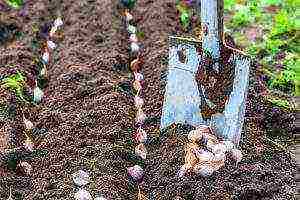
Garlic is one of the oldest vegetable crops, home to the foothill Central Asian regions. It is a seasoning, a hot spice, and a great medicine. Therefore, no vegetable garden is complete without planting this representative of the Bulbous family.
Growing garlic outdoors is usually not a big problem for gardeners. It is believed that this is not difficult. Still, it's not easy to grow a good harvest.
Compliance with the rules of agricultural technology, technology and planting care is necessary for the successful growth of this wonderful vegetable crop.
Garlic: the history of the plant
It is impossible to establish exactly from what time garlic has been present in people's lives. Already in ancient times, it was grown in India and used as a medicine.
Historians claim that they began to use it for food about 5 thousand years ago: the found manuscripts speak of the cultivation of garlic in Ancient Rome and Greece, Assyria and the Kingdom of Judah, Egypt and Arab countries.
He was found in the tombs of the pharaohs. The Bible and the Koran mention it, which testifies to the high recognition of this magnificent bulb as a spice and medicinal plant for ancient civilizations.
And today it is difficult to do without this culture, so we will deal with the intricacies of growing such a wonderful plant as garlic.
The site for planting is of decisive importance. It should be flat, not flooded by spring floods and located on the sunny side.
It is imperative to observe the order of crop rotation: garlic should be grown in the same place for no more than 2 years.
The ideal plant predecessors are squash, peas, potatoes, cucumbers.
The soil should be moderately fertile, well-drained. The general rule for planting is to observe the intervals: 8-10 cm between the teeth and 18-20 cm between the rows.
Access to air and light is a prerequisite for good crop growth. In addition, such distances are optimal for subsequent fertilization and weeding.
An indispensable rule of quality selection of garlic cloves for planting is the choice of the right variety. There are two types of bulbs - winter and spring. You can plant it in the spring - then you need spring garlic. Planting before winter, of course, involves winter varieties.
Bulbs should be selected large, without damage. Divide them into cloves should be immediately before planting. A feature of winter garlic is that it needs long-term stratification for successful growth, that is, staying in cold conditions for several months.
That is why it is planted before winter. For high-quality vernalization of garlic at the beginning of development, low temperatures are also required, and this regulates the timing of sowing spring garlic.
It is planted in early spring, as soon as the snow has melted, so that the vernalization time (up to 40 days) passes at an air temperature of + 5–10 ° C.
Planting garlic before winter
Among Russian gardeners, the main representative of bulbous plants planted before winter is winter garlic.
Growing it is a responsible business: you need to work in the fall, observing the planting conditions, taking into account the time and place, tillage and applying the necessary fertilizers, and in addition, choosing the right variety.
The garden for planting garlic should be started a month before planting. The earth must be well dug up, weeds and roots must be removed.
Then the soil must be carefully leveled and shed with peat-humic fertilizer for nutrition and disinfection. After 10 days, humus or well-aged manure infusion is applied at the rate of 10 liters of fertilizer per 2 sq. m.
The earth must be loosened, shed and grooved, then ash and sand must be added to them to avoid the formation of rot.
Terms and technology of planting winter garlic
A favorable time for planting in non-black earth regions of Russia is the third decade of September.
You can't plant the garlic earlier - the cloves will have time to release the greens and freeze, and the roots will weaken. If planted later, the garlic will not have time to take root.
Garlic is planted, deepening it by 10 cm, in the prepared grooves, well spilled with water in advance.
Important! Growing garlic outdoors suggests some peculiarities.
When planting, it is impossible to press in the cloves with force (summer residents often sin with this) - pushing off from the compacted soil, the sprouting roots will begin to push the bulb upward, which will lead to freezing.
The final stage of planting is leveling the soil, mulching with peat, sawdust and warming from above with spruce branches. In dry autumn, garlic should be watered once a week. A large harvest of garlic can be expected during a good winter with snowfalls.
Therefore, if the winter has little snow, and the planting areas for garlic are small, snow should be thrown on the beds. Subject to these simple rules, the future harvest of garlic will be reliably protected from adverse influences.
Spring garlic: cultivation and features
To activate the growth processes, the separated cloves are treated as follows: for 10-12 hours they are soaked in a growth stimulant solution with the addition of several grains of manganese for the prevention of diseases.
So, having chosen the variety of spring garlic you like, having processed it accordingly, they proceed to spring planting.
Note that the early planting of garlic is also explained by the temporary supply for the complete ripening of the bulbs, which is a guarantee of their high quality and excellent keeping quality.
There is an opinion that spring garlic is more useful than winter garlic and does not lose its medicinal properties and presentation during storage.
Growing garlic outdoors, especially from the early spring days, requires maintaining the same intervals as when planting before winter, and then carefully monitoring the germination and condition of the shoots.
Garlic is extremely sensitive to soil acidity, so fresh manure cannot be applied. Only humus should be used as top dressing. When planting garlic in spring, it is useful to add urea at the rate of 30 grams to irrigation water. 10 liters of water.
This amount of solution is enough for 2 square meters. m. In addition to nitrogen fertilizers, potassium-phosphorus fertilizers are also needed. The first shoots appear in 12-18 days. During the formation of leaves, fertilizing with wood ash is necessary.
In addition, it is an effective pest repellent.
The agrotechnology of growing garlic is simple. The main condition for the good development of the bulbs is timely feeding. But it is equally important to ensure planting with regular watering.
Lack of water has a detrimental effect on the development of the bulb, therefore, the main issue is to ensure optimal planting moisture. It is important not to overdo it - excess water is harmful. Watering in the amount of 10 liters per m² is considered the norm.
By the time the garlic ripens, watering is gradually reduced, in the last 2-3 weeks before harvesting, the need for water disappears. Regular weeding and loosening of row spacings are equally important.
Harvesting of garlic is carried out at the end of the plant's life cycle - between the yellowing of the leaves and their drying.
Growing garlic from bulbs
The number of cloves in the bulb is limited, so the most promising is the propagation of the culture with bulbs or air bulbs.
Their use increases the reproduction rate of garlic several times. In the northern and temperate latitudes of Russia and Siberia, air bulbs are planted in the spring, and it is very important to preserve them in the winter.
They are well stored in inflorescences at a temperature of 15-20 ° C.Two months before planting, in early March, they are moved to a cooler place.
Growing garlic from bulbs predetermines several conditions: the bulbs must ripen and be well preserved.
They are planted in five lines with ribbons, deepening the bulbs by 3 cm, and then mulching the bed with humus. Care for the seedlings is the same as for spring garlic, that is, they are weeded, watered and fed with any organic matter in a timely manner.
In the fall, one-toothed beetles ripen, which are not removed, but left to winter, not forgetting to cover the crops and organize snow retention. In the spring they germinate and harvest in July-August.
Growing garlic from bulbs takes place in a two-year cycle, resulting in an excellent crop.
Rare culture - rockambol
The popular in Europe and Asia culture of rockambol, or hairstyle, is still rarely found in Russia.
But gardeners who have already become acquainted with this culture appreciated its excellent, pleasant taste.
By its biological characteristics, this plant is suitable for growing in all Russian regions.
Rocambol is a representative of the lily family, but outwardly resembles large garlic.
Rocambol, whose cultivation practically does not differ from the usual garlic, also loves fertile neutral soils, responsive to organic fertilizing and weeding. With proper care, the bulbs of this culture reach 250-300 grams.
Diseases and pests
Many pests parasitize plants, causing irreparable harm to garlic. The most common of these are the stem nematode and the garlic mite.
They are able to harm not only during the development of culture, but also during storage. In addition to phytophagous insects, there are also diseases of garlic, the most dangerous of which are peronosporosis, cervical rot, and fusarium.
The main measures to combat diseases and pests are preventive measures: compliance with crop rotation, timely destruction of affected plants and infected bulbs, preparation of planting material.
Careful use of fungicides is also possible. The industrial cultivation of garlic implies a more intensive use of such preparations.
Nevertheless, it is the modest summer cottages that give a healthier harvest, since any gardener is very picky about the use of chemicals, preferring to do with more gentle methods.
Growing garlic in the open field involves simple, but demanding operations, the implementation of which guarantees a good harvest of a wonderful crop.
Growing garlic outdoors or how to get a good harvest from every garden

Garlic is also mentioned in inscriptions left on the surface of the ancient Egyptian pyramids. He managed to find a clay bulb inside the tomb of Tutankhamun himself.
And the world famous Pythagoras called everyone's favorite garlic the king of spices. And it was not in vain that he received such a sonorous name. Although known to the whole world for about 3 thousand.
years, but continues to be popular among the population of countries such as Italy, Korea, India, China.
The gardeners of our country have been successfully cultivating garlic for many years.
Many, especially beginners, are interested in proper planting and care in the open field, so we will talk about the key points in more detail below.
Now you will find out when it is better to plant a crop, how to prepare the beds, how to self-plant.
Disembarkation dates
Nowadays, breeders have managed to breed many excellent varieties of garlic. Among them, you can choose three for growing on your own personal plot.
These are non-shooting winter crops, non-shooting winter crops and non-shooting spring varieties known to experienced gardeners. As for their characteristic features, winter crops ripen early, have large heads and teeth, and have good yields.
But they are not able to be stored for too long. Used for the preparation of various dishes and preservation.
Winter varieties include such as Yubileiny Gribovsky, Komsomolets, Boguslavsky, Gulliver, Petrovsky and others.
Spring varieties require special storage conditions and can be stored for a long time.
Popular types for planting in open ground are Yelenovsky, Ershovsky, Degtyarsky, Gafuriysky, Ukrainian white.
Shooting varieties of winter garlic, which tend to form a bulb with 2 - 6 large teeth, and non-shooting, which form a multi-pronged bulb, are recommended to be planted on the site 35 - 45 days before frost.
This time falls in the second half of September - early October. Before planting, large and medium bulbs are selected, divided into prongs, weighing no more than 6 grams. Bulbs that have 2 to 3 prongs are not used.
It is advised to renew the planting material every 3 to 4 years.
The recommended timing for planting spring garlic is early spring. You can plan planting for the first days of sowing, but no later than the first ten days of April.
Spring bulbs are often multi-toothed bulbs. It is better not to choose teeth that are medium in size for planting.
Garden bed preparation
It is important to properly prepare the land for cultivation. It is recommended to choose an area with fertile soil that has a neutral acidity level. Garlic will grow well in loamy soil.
It shouldn't be too dry. You can not plant the plant in the lowlands. Since there often accumulates rain and water remaining after the melting of snow. The site should be dug up in the fall.
It is required to do this to a sufficient depth. Do not forget to add about 30 grams of superphosphate, 20 grams of potassium salt and 1 bucket of humus per square meter of area.
With the arrival of spring, you only need to level the site using a rake for this purpose.
All cabbage pitchforks, as well as pumpkin, zucchini, beans, peas, green manure are considered excellent precursors for garlic. It is not recommended to plan the planting after carrots, cucumbers, tomatoes, onions and garlic.
The neighborhood with garlic is useful for crops such as black currants, potatoes, raspberries, gooseberries, strawberries, wild strawberries. Garlic will definitely be a reliable protection for them from pest attacks.
How to plant
It is permissible to plant garlic in the presence of a soil temperature of about 12 - 15 degrees Celsius. Then the culture will be able to form a strong root system. This will increase the degree of winter hardiness of the plant.
Before planting, the site must be leveled. The spacing in the row spacings is normally from 20 to 25 cm. The spacing between the teeth is no more than 12 cm. It is permissible to plant them in furrows, but without pressing them into the soil. Planting depth is somewhere around 8 - 9 cm.
To prevent the teeth from freezing, it is advised to use planting material 6 - 7 cm in size. The bed must be mulched. For this, high-quality humus, peat or sawdust are used. The brushwood spread over the site will be able to retain snow in the beds.
Remember to remove the top layer when the spring thaw begins.
Outdoor care
To get a good harvest, it is necessary to regularly water the plantings, carry out weeding and loosening, and make certain top dressing.
You should also remove the arrows that appear, which take away strength and useful elements from garlic, directing them to the formation of planting material.
You also need to know how to help the culture in the event that it is attacked by diseases and pests. Next, we will tell you more about proper watering and fertilization.
Watering
Watering the crop is required as the soil dries up. If the weather is rather dry, it is necessary to carry out abundant watering. Its frequency is usually 10 to 12 liters per square meter.
If it rains constantly, natural rainfall should be enough for the plants.Then it is easier for the gardener, because there is no need for watering at all. Watering must be stopped in August.
At this time, the bulbs already have time to gain sufficient weight and volume. That is, they are fully formed.
Fertilizers and feeding
Garlic gratefully responds to fertilizing with mineral and organic fertilizers. Top dressing is required in early spring. You will need high-quality potash and phosphate fertilizers. To get a good harvest, you need to fertilize three times.
For the first time, superphosphate is used in an amount of up to 100 grams, ammonium nitrate - about 60 grams and the same amount of potassium sulfate per square meter. The second feeding is carried out 1 month after the first. The same fertilizers are used and in the same amount as for the first one.
When the heads are about the size of a walnut, you can fertilize the plants a third time. When feeding in the spring, remember that nitrogen-containing fertilizers are needed only at the beginning of the growth of garlic.
Later, it is permissible to use only preparations containing sufficient quantities of elements such as phosphorus and potassium. Their deficiency can provoke yellowing of the surface of the foliage of the culture. You can feed your favorite culture in the summer.
To do this, in June, a solution of 10 liters of water is added to the soil with the addition of 2 tablespoons of superphosphate, which is watered over the beds.
Diseases and pests of garlic
Of the characteristic diseases for the plant, sulfur, cervical and white varieties of rot are dangerous, as well as fusarium, helminthosporiosis, jaundice, smut, peronosporosis (aka downy mildew), mosaic, tracheomecosis, and rust. The pests of garlic are tobacco thrips, stem nematode, onion lurker, cabbage caterpillars, winter, garden and gamma scoops, onion and sprout flies, onion moth, long-legged, bear.
Prevention of the appearance of troubles is the observance of crop rotation and the rules of agricultural technology.
Planting the culture in the old place can be carried out after 4 - 5 years, the crop storage should be treated with a solution of 400 grams of bleach, dissolved in 10 liters of water, a few months before laying the garlic.
The pre-sowing treatment of the bulbs and tines also plays an important role. The teeth are advised to warm up at a temperature of about 40 - 42 degrees Celsius for 10 hours.
For the treatment of diseases, it is customary to use modern fungicidal agents. For example, having identified foci of rust damage to the culture, the gardener can purchase the drug "Hom" based on copper oxychloride.
With which the plant should be processed. In the early stages of defeat, such fungicides as "Kuproksat", "Gamair", "Champion" are effective.
The drugs "Tiram", "Polycarbocin", "Fentiuram", "Arcerida" are effective against peronosporosis. The modern drug "Fitosporin" successfully fights against all fungal diseases.
With its solution, not only the soil should be treated, but also the seeds and storage of the crop.
"When and how to plant garlic outdoors"
In this video, you will learn about when and how to plant garlic outdoors in autumn.
Planting garlic in the open ground in spring - rules that should not be neglected
The upcoming planting of garlic in the open ground in spring is the most important event for every vegetable grower.
This bulbous plant is of great value in cooking, folk medicine, it is used in many dishes and for homemade preparations.
With the right approach, the harvest of this crop is able to bring the owner of the site a regular income.
Planting garlic in spring
On the farm, winter garlic is more often used for processing, selling on the market and preserving; it is distinguished by large cloves and better yields.
If the question arises about long-term storage, then varieties for spring sowing have an advantage. Winter bulbs are normally stored until early January, after which their quality deteriorates, and spring bulbs do not deteriorate until mid-spring.
If there is a spring planting of garlic in the open field, then it is better to purchase the following varieties:
- Gulliver;
- Abrek;
- Sochi 56;
- Aleisky;
- Yelenovsky;
- Victorio;
- Permyak.
The difference between spring and winter garlic:
- Predominantly spring garlic does not form arrows.
- Spring bulbs do not hibernate in the open field; they begin to plant it in the spring.
- In a bulb of spring garlic, up to 30 cloves can be formed, winter garlic has no more than 10 cloves.
- The cloves of this garlic become smaller towards the center of the head and are arranged in a spiral.
- Bulbs in winter species grow larger when planted outdoors.
- Planting garlic in the open ground in spring is carried out with the cloves of the harvest of last year, the propagation of winter garlic can be done with air bulbs.
Planting garlic in spring in open ground - timing
This culture has little time for the growing season, therefore, in the open field, the timing of planting garlic in spring begins in the southern regions already at the end of March when the soil is heated to a temperature of 5-6 ° C.
For the Moscow region and more northern regions with a cool climate, the work time is shifted, depending on weather conditions, to the third decade of April or even to the first days of May. Try not to delay the planting time.
Delay in timing can lead to a drop in yields by 50% or more in dry years.
Preparing garlic for planting in spring
Bulbous plants in the open field suffer from many diseases, so you need to study well the problem of how to prepare garlic for planting in spring.
To begin with, we disassemble the heads into teeth, selecting the healthy and largest slices, which are often located closer to the edge.
Next, you should process the resulting material in a solution of a proven and available fungicide.
How to process garlic before planting:
- Soak the cloves in a solution of potassium permanganate for 30-60 minutes.
- Soaking in 1% copper sulfate solution (for 30 minutes).
- Use the antibacterial drug "Maxim" or its analogues.
- Use a strong saline solution in the ratio of 3 tablespoons of salt to a 5 liter bucket of water in the spring, just before planting in the open field. Duration of soaking is 3 minutes.
- Soak the slices for half an hour in Fitosporin-M, diluted according to the instructions.
- Use the infusion of wood ash (a tablespoon of this natural micronutrient per liter of water) on the eve of planting garlic in the open field in the open ground, processing time - 1 hour.
Garlic precursors when planting
When working outdoors in spring, it is imperative to observe crop rotation to reduce the risk of fungal spread and improve soil composition. Tips for planting garlic experienced gardeners recommend avoiding predecessors in the form of potatoes, tomatoes and onions.
The garden bed, where last season alfalfa with clover, strawberries, green salad grew, is perfect. A smart choice of neighbors for garlic, which contains natural phytoncides that help effectively repel pests.
It is advisable to place the beds with bulbs between the plantings of strawberries and carrots.
Ways of planting garlic in spring
The generally accepted rules for planting garlic in the spring always recommend setting a row spacing of about 20-30 cm. We make small holes, we maintain the distance between adjacent slices in rows up to 6-8 cm.
We lay out the slices with their bottom down without pressing into the ground.
To facilitate this process, experienced hobbyists use household hand planters or homemade markers in the spring on large areas in the open field.
Planting depth of garlic in spring
For early spring and winter plantings, different rules for growing this crop are used. The planting depth of spring garlic in spring is about 5-7 cm.
For comparison, recall that when planting before winter, the teeth should be buried in the open ground up to 8-12 cm, depending on the composition of the soil at the site.
Too shallow planting is undesirable, fast-growing roots often push the teeth out, where they die in the heat. Deep deepening will slow down the germination of garlic.
Fertilizer for garlic when planting
It is advisable to use the most fertile soil for garlic, but in the open field it is forbidden to bring fresh organic matter into the holes.
Due to the very early period of work, it is better to prepare the site for winter, always adding nutrients for digging into the ground - humus (up to 5 kg / m2) and superphosphate (15 g / m2).
Fertilizers when planting garlic in spring are allowed to apply the following:
- The first feeding - 15 days after germination, we add urea in the form of an aqueous solution (1 tbsp. L / 10 l of water).
- The second feeding - after 12-15 days, it is recommended to use a nitroammophoska (2 tbsp. L / 10 l).
- The last top dressing in the open field - in the last decade of June, you can apply superphosphate in the form of an aqueous infusion (2 tbsp. L / 10 l) with an application rate of up to 4 l / m2 of the garden.
| When sowing carrots in the open ground in spring, it is advisable to be guided by the developments of scientific agronomists and the valuable advice of successful amateurs. Growing root crops is not an easy task, in which many complex nuances await a novice vegetable grower. | Information on how to properly plant cucumbers for seedlings, when it is best to do it and what further care should be, is important for those who want to grow healthy and strong plants and get a good harvest. |
| Gala potatoes - characteristics of the variety, cultivation features Gala potatoes are the development of German breeders who wanted to create a unique variety with good immunity, high productivity and ease of maintenance. The characteristics of this culture are amazing. | How to plant cucumbers for seedlings correctly and ensure a good harvest? Only after learning how to plant cucumbers for seedlings correctly, you can get friendly and productive shoots. The seedlings of this vegetable need to be germinated using fertilizers, abundant watering and fertile soil. |
Correct planting of garlic outdoors in spring
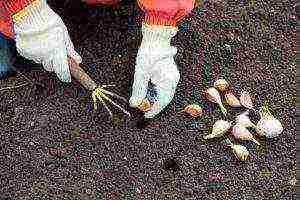
Garlic is a very healthy and popular crop that every gardener grows. The process of obtaining a rich harvest and planting in spring in open ground is quite simple, and even a beginner can cope with it, the main thing is to follow all the rules.
Recommendations regarding planting will be especially important, because the quantity and quality of the spicy heads obtained will depend on it.
With the help of step-by-step instructions, planting and growing heads of garlic in the country will not be difficult in the Moscow region, and in Belarus and even in Transbaikalia.
Garlic can be planted in both autumn and spring. The specific term will depend from the selected variety.
Experienced gardeners know that such a crop can be represented by winter or spring varieties. These two species differ from each other not only in terms of planting, but also in many other characteristics. You can plant and transplant them at different times, the same applies to sowing seeds for seedlings.
To distinguish them from each other, you need to know the main external signs of each species:
- winter garlic is planted in the fall, it is larger, the lobules are covered with a hard shell. In the middle there is a thick and hard rod, around which the teeth are located;
- spring is placed in open ground in early spring... Such heads are smaller, their skin is soft and resembles parchment. The teeth are small, their arrangement is chaotic.
Differences between spring and winter garlic
Winter garlic is suitable for fresh consumption and conservation, such varieties are stored for only 3-4 months. Spring has a less intense taste, but you can use it until the next harvest.
The specific dates of planting will depend on the climatic conditions of the region:
- When carrying out an autumn planting, it is worth remembering that by the time the first frosts appear at the beginning of winter, the teeth should have time to form a powerful root system, this process takes 3-4 weeks on average. Based on this, all work should be carried out a month before the onset of frost, that is late September-early October;
- Spring planting is carried out immediately after the winter snow cover melts, and the garden soil warms up to +6 degrees. Depending on the specific region, this may be April or early May.
When making a choice at what time to plant garlic, you need to think about the fact that not only the process of work depends on this, but also characteristics of the resulting crophow it will emerge and whether it will be necessary to transplant in the summer.
The future harvest depends on the time of planting.
| Winter garlic | Spring garlic |
| The taste of spring garlic is less intense, and the heads and cloves are small in comparison with winter varieties. | Winter garlic boasts large prongs that are easy to peel before cooking and have a bright, spicy flavor. |
| Spring garlic ripens for a long time, the yield of varieties of this type remains at a low level | Winter garlic ripens a month earlier than spring garlic, so you can use fresh tines already in summer, besides, the yield of this species is much higher |
| Spring garlic is able to maintain its freshness for up to 12 months | Winter garlic is only stored for 3-4 months |
| Spring planting guarantees a friendly emergence of seedlings and safe growth of plants | When carrying out an autumn planting, it should be borne in mind that there is always a risk of an earlier onset of frost or too much precipitation, which can destroy the planting. |
| When caring for spring garlic, you should take care of sufficient watering during the formation of the teeth. | Winter varieties are formed using soil moisture |
| Spring varieties of garlic are not afraid of common diseases and pests | Autumn varieties are the most defenseless against various ailments. |
The choice of planting dates and the type of vegetable grown will depend on the growing purpose. Experienced gardeners recommend planting in the beds both winter and spring crops plants.
Gardeners recommend planting those other varieties in the beds.
Each planting date has its own individual characteristics regarding the work. But there are also general rules that should be followed regardless of the time factor:
- Before planting a vegetable, you must definitely calibrate, that is, to remove too small and somewhat diseased heads;
- The most common mistake many gardeners make is planting winter crops in the spring. In this case, you can get a harvest, but it will not be as tasty and large as with an autumn planting;
- In order to get a guaranteed yield, you should purchase zoned varieties... It is also worthwhile to study in advance all the characteristics, technology, how to sow and needs;
- Once every 3 years, you need to carry out rejuvenation of the variety, that is, instead of teeth, bulbs will be used as planting material, from which one-tootheds ripen in the first season. The resulting crop is used for planting the next year. As a result of such work, the garlic is renewed;
- In order to harvest a high-quality crop, the deadlines must not be missed. You can identify them by the arrow that should burst. Bulbs should also form;
- For a richer harvest, garlic feathers should be picked in a timely manner.
Before planting, the seeds need to be calibrated
The most important rule to follow when planting garlic will be deadlines.
In the fall, you cannot plant the teeth too early so that they do not germinate ahead of time, in the spring you cannot delay planting, because then the heads may not have time to mature before the onset of cold weather.
In order for the cultivation to end with success, you need to correctly carry out the planting work. It is also very important to competently look after the plantings and perform the necessary work in a timely manner.
Preparing seedling cloves
In order to get friendly shoots, which will subsequently bring a good harvest, you need to work hard and properly process the planting material:
-
- Well-dried garlic heads are divided into cloves without damaging dry scales;
- Then spend calibrationselecting large and healthy slices;
- Before spring planting, the cloves can be stimulated to a faster emergence of roots, for this planting material wrapped in a damp cloth and put in the refrigerator for several days;
- Before planting the teeth in the ground, they must be prepared.
There are three ways to carry out processing:
-
- The slices are soaked in warm water for 10-12 hours;
- For these purposes, table salt is also well suited, which is diluted in water (3 tablespoons per 5 liters). This procedure is carried out for several minutes;
- Another way would be chemicals that have a stimulating effect.
- The last important procedure will be disinfection... To do this, the teeth are immersed in a solution of copper sulfate for 1-2 minutes (1 tablespoon per 10 liters of water).
Disinfection is carried out in a solution of copper sulfate
Potassium permanganate solution, Fitosporin-M and ash infusion are also well suited for antimicrobial treatment. In this case, the processing will take 30 minutes.
Garlic is quite capricious about the choice of soil and planting sites. When preparing a site, you should remember about all the preferences of this culture:
- in the best way the vegetable takes root on loamy and chernozem soils with neutral acidity;
- the place should be sunny and open;
- it is not recommended to plant garlic where onions, potatoes and tomatoes grew before it. Desirable precursors include cabbage, legumes, courgettes and cucumbers.
For spring planting, soil preparation is carried out in the fall, and for autumn planting a month before work. This procedure includes deep digging, loosening, removal of weeds and stones.
In order to balance the composition of the soil, clay and sandy soil is diluted with peat, and peaty loam.
Clay and sandy soils are diluted with peat
In order to get a rich harvest, before planting the soil you need enrich... The following fertilizers are applied to one square meter of soil:
- 1 bucket of humus or rotted manure;
- 1 bucket of compost;
- 1 cup dolomite flour;
- 1 tablespoon superphosphate;
- 1 tablespoon of nitrophosphate.
The final part will be the disinfection of the plantings, during which the beds are watered with copper sulfate or a solution of potassium permanganate. Experienced gardeners recommend covering the ridges with foil until the work is done.
Step-by-step instructions and at what depth to plant
The vegetable is planted in rows, the distance between which should be equal 20-25 centimeters... The distance between individual teeth will depend on their size, on average this figure is 10 centimeters.
The teeth deepen strictly vertical... In the spring, the embedment depth will be 5-6 centimeters. In the fall, this figure should be increased to 10 centimeters. This is necessary in order to protect the planting material from freezing.
Autumn, immediately after planting the beds, it is recommended to mulch with straw or dry grass. As soon as the snow melts, the shelter is removed.
Care
Caring for the garlic after planting will consist of timely loosening and cleaning the soil from weeds... Also, do not forget about watering. During the growing season, moisture should be applied abundantly.
Watering is reduced to a moderate amount when the fruit begins to form, because with an excess of moisture, garlic can be susceptible to various diseases. In rainy weather, watering should be reduced. Moisture application is stopped 2 weeks before harvest.
In addition to watering, garlic needs regular feeding:
- 1 time in 10 days the soil is watered with a solution of phosphorus and potash fertilizers;
- At the beginning of the growing season and after the formation of the head, the plants are fertilized with infusion of mullein or chicken droppings. 1 kilogram of fertilizer is diluted in 10 liters of water and infused for several days. After the end of fermentation, 1 liter of top dressing is diluted with 10 liters of water.
For additional protection against diseases and pests, preventive treatments with fungicides and insecticides are carried out in the spring.
To protect against diseases, spraying with fungicides is carried out in the spring.
It often happens that after the autumn planting of garlic, the gardener's plans change dramatically and the beds have to be transplanted to a new place. Many sources do not recommend carrying out such a procedure, because it can damage the root system of plants and destroy them.
But if work is necessary, then the planting is transferred together with a large earthy clod... In this case, losses will be minimal, but in any case, a smaller yield should be expected.
You can plant garlic in spring and autumn. The specific timeframe for the completion of the work will depend on the desired result. The key to successful work will be compliance with all the above rules.
Garlic is a popular herb in many countries around the world. It has a unique taste and peculiar aroma. Some people do not like this vegetable precisely because of its characteristic smell. More than 400 components that have a positive effect on the general health of a person are contained in the bulb of the plant. This vegetable crop helps to get rid of many diseases and viruses. The article will tell you in detail about this vegetable culture, you can learn more about the varieties and features of care from the video at the end, under the description.
Useful properties of garlic
The beneficial substances contained in garlic help reduce blood pressure by relieving stress in the work of blood vessels.
Garlic contains vitamins A, K, E, With and vitamins of group B and B12, as well as thymine, riboflavin, folate, niacin... In addition, the vegetable contains selenium, iron, copper, manganese, zinc, phosphorus.
Scientists confirm that garlic helps to cope with the following diseases:
- lack of vitamins;
- the spread of parasitic worms;
- infections of a bacterial or viral nature;
- diseases of the heart and blood vessels;
- hypertension;
- impotence;
- thrombophlebitis and venous disease;
- joint diseases;
The difference between spring and winter garlic
The most common in our country are winter varieties of garlic. But in the northern regions, according to gardeners, it is best to grow spring garlic, since a vegetable planted in winter can freeze.
Spring varieties are distinguished by their small bulb size, with a large number of scales. The cloves of the bulb are from 12 to 30 and they are arranged in a spiral, from larger ones at the edges to small ones in the middle. Planting varieties of plants of this type is carried out in early spring, and you can harvest in September, stored until the next harvest ripens.
Winter garlic varieties have a large bulb with large teeth, they grow around a rod that sticks out of the bottom. The number of prongs in a bulb is from 4 to 12. This type of plant is planted in the fall and stored until February.
Winter garlic is more common, but in the northern regions they prefer to grow spring garlic, since winter garlic often freezes out.
Garlic varieties
All varieties of garlic can be divided into two groups:
- Shooters - in which the bulb has a flowering shoot ending in an inflorescence. It consists of bulbs (air bulbs).Yellowed leaves are a sign of ripening in these varieties. Arrowhead varieties are winter varieties.
- Non-shooting - varieties in which only leaves develop as they grow, are both winter and spring.
The best varieties of garlic for planting before winter
For planting garlic before winter, it is recommended to use winter-hardy varieties.
Shooting varieties: "Dubkovsky", "Parus", "Saki", "Otradnensky", "Jubilee", "Gribovsky".
Garlic varieties for planting in spring
Spring varieties are well kept and are represented by numerous local forms. These include:
- "Cheboksarskiy" - a variety grown in Chuvashia;
- "Danilovsky" - a variety of the Yaroslavl region;
- "Bryansky", "Ufimsky" - varieties of Bashkortostan.
Growing garlic outdoors
 Garlic, planted in a summer cottage, has a positive effect on the growth of other garden crops, and in a mature form it can be useful as a health promoting tool.
Garlic, planted in a summer cottage, has a positive effect on the growth of other garden crops, and in a mature form it can be useful as a health promoting tool.
The timing of planting garlic depends on its variety. Different planting times for spring and winter species, there are also other differences between them. Our article provides information about these two types of garlic and the secrets that gardeners need to know, as well as a detailed description of how this culture helps the summer resident in the beds.
The conditions for growing garlic are quite simple, but some peculiarities must be taken into account. This vegetable needs the soil in which it will be planted to be fertile, a good harvest can be obtained on cultivated sandy loam and loamy soils, with neutral acidity.
The garlic should be planted in a lighted area as the plant needs sunlight. Most often, this crop is grown in the garden, but sometimes, to save space, along with other vegetables or berries. Garlic is best planted in the neighborhood of:

- Strawberries;
- Bow;
- Cucumbers;
- Raspberries;
- Strawberries;
- Potatoes;
- Gooseberry;
- Black currant.
A good neighbor will be a vegetable for such flowers: gladioli, tulips and roses.
Garlic repels pests from its neighbors - other plants. Even a mole won't dig a hole next to this vegetable. Roses also need close proximity of this culture, as this saves flowers from the occurrence of spotting.
Garlic, planted nearby, inhibits and slows down the growth of cabbage, beans, peas. At the same time, these cultivated plants are good precursors for the subsequent cultivation of garlic, as well as pumpkin.
On an onion or your own, last year's garden, the agricultural technology of growing a vegetable is possible only after 4 years.
Garlic propagation methods
Garlic reproduces vegetatively, since it cannot be grown from seeds. The spring species is planted in the beds with chives, and winter garlic is planted with chives and bulbs.
An airy bulb-bulb is formed in 2 years. In the first year of growth, a small-sized bulb-set is formed from one clove, and the next year the remaining cloves appear and the entire bulb is formed. At the same time, a plant from one clove is also complete and has a lot of useful qualities.
Most often, summer garlic is propagated by chives, since this type of planting brings a crop of full-fledged bulbs in the same year.
The amount of the crop will depend on the quality of the planting material. It is recommended to heal the teeth before planting, and also use different varieties.

Teeth, before planting in the ground, you must:
- Sort by size, remove small, diseased (with a depression at the bottom) and uneven, double, irregular shape;
- Seeds selected for planting should be large, hard and have a dense, whole shell;
- The planting material is disinfected in ash liquor. The solution is made in the proportion of 400 g of ash per 2 liters of water. The resulting mixture is boiled for 30 minutes, after cooling, the chives are soaked in liquid for 2 hours;
- Before planting in the ground, spring garlic can be germinated in advance to increase the growth rate. The teeth are wrapped in a cloth moistened with water and placed in a plastic bag, after 2-3 days the first shoots appear. The germination procedure is carried out at room temperature;
- Bulb bulbs are selected only for the largest ones. Small bulbs are poor-quality planting material that will not be able to bring a good harvest.
Spring garlic cultivation technology
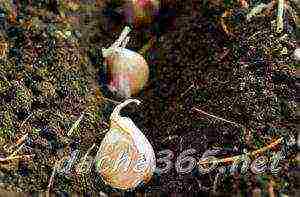 In the spring, a spring type of garlic is planted on the beds. Planting is best done in mid-late spring, after the snow melts, when the ground temperature reaches +5 - +7 degrees. If the cloves are planted in moist soil, then watering is not necessary, if the soil is dry, it is necessary.
In the spring, a spring type of garlic is planted on the beds. Planting is best done in mid-late spring, after the snow melts, when the ground temperature reaches +5 - +7 degrees. If the cloves are planted in moist soil, then watering is not necessary, if the soil is dry, it is necessary.
To calculate the planting depth, it is necessary to multiply the height of the clove by 2. The resulting value is 5-6 cm. Sprouted summer garlic is planted carefully, trying not to damage the roots. After planting, the garden bed is mulched.
Garlic is planted in rows every 18-20cm. The gap between the teeth is from 8-10cm.
The first sprouts of garlic appear at a temperature of +3 - +4, they are not afraid of frost. Each stage of development requires its own temperature regime. The best indicators of air temperature:
- during the growing season from +5 to +10;
- at the stage of bulb formation from +15 to +20;
- at the stage of ripening from +20 to +25.
During the hot summer, it is recommended to mulch the garlic beds. Mulch is best used in a light color.
Watering
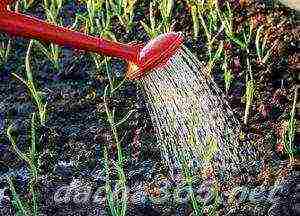 It is necessary to water the plant correctly during the entire growing season. In the first phase, when active growth occurs, watering should be abundant, in the second, when the bulb ripens, it should be moderate. With heavy rainfall and prolonged cloudy weather, you do not need to water the garlic. Since excess moisture in the second growing season is very dangerous and can provoke the onset of diseases and damp bulbs.
It is necessary to water the plant correctly during the entire growing season. In the first phase, when active growth occurs, watering should be abundant, in the second, when the bulb ripens, it should be moderate. With heavy rainfall and prolonged cloudy weather, you do not need to water the garlic. Since excess moisture in the second growing season is very dangerous and can provoke the onset of diseases and damp bulbs.
Fertilizer
Plant feeding is carried out 2 times per season:
- in the spring, on the ground from which the snow has just melted - with a solution of rotted manure, taken in a ratio of 1:10 or bird droppings, prepared in a ratio of 1:12;
- in summer, in June or July - a solution with wood ash, taken in a ratio of 200g per 1 bucket of water.
When growing this vegetable crop, you should not use mineral fertilizers, since this will only harm the soil and future harvest.
Loosening the soil
Garlic beds need periodic loosening and cleaning of weeds. The mulching procedure will greatly facilitate the maintenance of the site, allowing you to reduce the amount of watering and eliminate the need for loosening and weeding.
Watch the video! Features of growing spring garlic
Growing winter garlic
In autumn, in September-October, winter varieties of garlic are planted, industrial cultivation of this type is carried out at the same time. It is very important to land on time. Premature growth and reduced tolerance to low temperatures causes planting too early. Garlic, planted late, does not have time to gain a foothold in the soil with the help of the roots, since frosts will come.
The garden for planting winter garlic must be started 2 weeks in advance. Furrows are formed on the site, on the bottom of which sand or ash is poured, about 1.6-3 cm thick. The layer protects the teeth from diseases such as rot and contact with the soil.
Winter species are planted in rows in rows, at a distance of 20-25 cm from each other. The gap between small cloves is from 8 to 10 cm, and between large - from 12 to 15. Planting winter garlic in loose soil, it is necessary to a depth of 15-20 cm.
The garden bed, after planting the garlic, is recommended to mulch. A layer of mulch is laid out with a thickness of 1.5 to 2 cm, it additionally protects the vegetable crop from frost. To prepare mulch, wood sawdust mixed with soil or dry peat is used.It is necessary to cover the area with polyethylene as a protective material during the period of autumn frosts. With the arrival of the first snow, the beds are reopened. You can also protect planted garlic with a thicker layer of mulch.
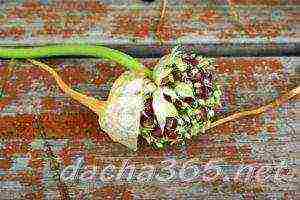 In the same period of time, bulb bulbs are planted, to a depth of 3 cm, according to a scheme of 2 by 10 cm. They can be sown in the first half of April.
In the same period of time, bulb bulbs are planted, to a depth of 3 cm, according to a scheme of 2 by 10 cm. They can be sown in the first half of April.
In the autumn, the bulbs, consisting of one clove, are dug out in order to dry and plant in the ground again. After a year, a full-fledged onion can be obtained from a clove.
Winter varieties of this vegetable crop tolerate frost well and are resistant to negative weather conditions. Teeth that have developed roots tolerate winter well and can withstand temperatures down to -21 degrees. If the temperature drops below, and the snow layer is insignificant, then there is a high probability of freezing of crops.
Care
The rules of care that are relevant for spring plant varieties are also applicable to winter varieties. Garlic, after planting, needs mulching, temperature control, watering and feeding.
It is recommended to remove the plant arrows in winter varieties when their length is about 10 cm. Thus, you can increase the yield. In order to get the bulbous bulbs, leave a few plants with arrows.
Watch the video! Growing winter garlic
Garlic pests and diseases
Garlic during its growth period can be susceptible to the spread of diseases.
Rot of the bottom (fusarium)
Causative agent: mushroom.
Characteristic features of the appearance of the disease: yellow leaves, changes and wilting of the root system. At the bottom of the garlic, a white or pink layer of mycelium appears, which, with further spread, provokes decay.
Bacterial rot
Causative agent: bacteria.
Characteristic features of the appearance of the disease: the appearance of brown wounds on the teeth, which, with the further spread of the disease, look "frostbitten". Changes are manifested by a putrid odor and color change.
Downy mildew (downy mildew)
Causative agent: mushroom
Characteristic features of the appearance of the disease: leaves and arrows covered with a bloom with a gray tint, as well as unripe bulbs and dried parts of the plant.
White rot of garlic
Causative agent: mushroom.
The characteristic features of the lesion caused by the disease: a bloom of white mycelium on the roots and on the bulb of the plant, which, upon further spreading, leads to decay and death of the plant, as well as yellow leaves, which subsequently die off.
Black mold (stemphiliosis)
Causative agent of the disease: mushroom.
Characteristic features of the appearance of the disease: spots, yellow tint, which appear on the leaves and, as the disease spreads, become covered with black mold. The disease significantly reduces the volume of the crop.
The main preventive measures that must be taken in order to prevent the appearance of the disease are the treatment of the teeth before planting and their careful selection, as well as protection from pests and the removal of diseased plants.
Garlic suffers from the onion fly, which causes great harm to this plant, feeding on the tissue of the bulb and laying larvae on it.
This vegetable crop is susceptible to negative effects: onion hoverfly, onion thrips, root mite, onion moth and onion stem nematode.
It is best to plant chicory or calendula next to garlic, since these flowers, with their smell, can scare away pests, as well as decorate the garden.
Harvesting
Harvesting garlic from the garden, like harvesting onions, should be done in a timely manner. Winter varieties are poorly stored, so do not delay digging and drying the bulbs. It is necessary to take into account the weather conditions, if prolonged rains are expected, then the garlic must be dug up in advance. Long and hot summer, increases the rate of ripening of garlic.

Harvesting is best done earlier, as is the case with onions.Garlic that has been in the ground for too long is not subject to long-term storage, as it crumbles and falls apart. Unripe bulbs also wilt and deteriorate quickly. Therefore, it is best to harvest mature bulbs selectively.
You can determine that the garlic is ripe and needs to be dug out by the leaves that have turned yellow and wilted by a quarter of the length. However, when using this method, there is a high probability of an error, since the plant may suffer from diseases or excessive acidity, soil moisture.
The main reference point is the end of the period of maturation and growth of the plant, which occurs 100 - 110 days after the appearance of the first shoots. Each variety will have its own expiration date for the growing season.
You can also navigate by the bulb-bulbs, as soon as the shell in which they are enclosed bursts, it is necessary to harvest. But this method also does not always indicate the correct harvest date. Sometimes already matured heads remain closed with a shell for a rather long time.
Conclusion
In this article, each reader will find useful information about spring and winter types of garlic, as well as pests and viruses that significantly reduce the yield of the plant. You can also grow garlic in your summer cottage or garden in order to protect other crops from insects.
Watch the video! Growing garlic. Discovering the secrets of a great harvest
All about the correct cultivation of spring and winter garlic in the open field, about what to do if it turns yellow in spring, how to water and how to feed, you will learn from this guide. The information will be especially useful for beginners, as well as for experienced gardeners. The cultivation of garlic usually does not cause big problems, but for a good harvest, it is necessary to follow the rules of planting, care and feeding.
What is the difference between spring garlic and winter garlic
Gardeners know that there is winter and spring garlic, and what are the differences between them you will see from the table and photo:
| There are more teeth - from 12 to 30 pieces, but they are smaller | An arrow sticks out in the middle of the bottom, which is surrounded by 4-12 large cloves |
| The bulbs are smaller and have more scales | Bulbs and cloves are larger and more productive |
| The teeth on the bottom of the bulb are located in a spiral from the periphery to the center, with the outer ones being larger | In the middle there is a thick and hard rod, around which the teeth |
| Planted in early spring | Planted in autumn |
| It ripens in September, it is laid for winter storage and consumed until the new harvest | Can only be stored until February |

Winter garlic is more common, but in the northern regions they prefer to grow spring garlic, since the plants of sub-winter planting can freeze out.
Garlic varieties with photos and descriptions
Most often, garlic is propagated by chives, of which there are from 4 to 12 in each bulb, and sometimes more.
Do not use grocery store garlic as a planting material. It may not be suitable for growing in your area, and in most cases it has been treated with special substances that inhibit growth. It's best to buy garlic for planting from a trusted online seed store or local nursery.
Garlic varieties are divided into two groups:
- Shooters - they have a flowering shoot coming out of the center of the bulb - an arrow ending in an inflorescence. It consists of bulbs (air bulbs) and flower buds, which subsequently dry out without forming seeds. A sign of ripening in them is the yellowing of the leaves and arrows. All arrowed garlic varieties are considered winter garlic.
- Non-shooting - in such plants only leaves develop during the growing season. These varieties can be both winter and spring varieties.
The best varieties of garlic for planting before winter
For podzimny planting, varieties with high winter hardiness are recommended.
Shooters
Dubkovsky is a medium-ripening variety - 98-114 days pass from germination to harvest. Productivity 5.6 kg per 10 m2.Bulbs weighing 30 g, round-flat, dense. There are 10-12 cloves in an onion. The taste is spicy. Recommended for growing in the Krasnodar Territory, Kurgan, Rostov and Pskov regions.
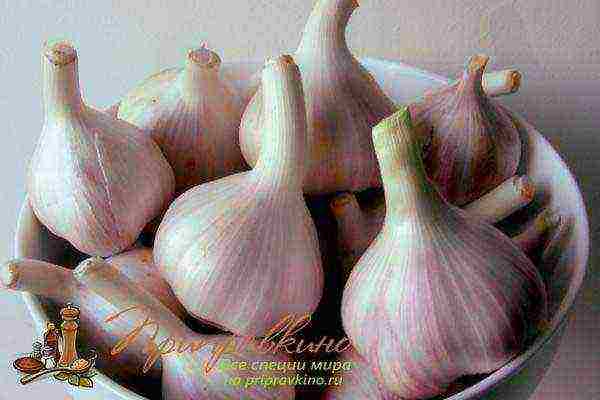
Yubileyny Gribovskiy is the most widespread variety of the middle term - from germination to drying of leaves 83-122 days pass. The yield is high - an average of 12.5 kg per 10 m2. Bulbs of 20-30 g, round-flat, with large cloves. The taste is very spicy. The variety is relatively winter hardy, resistant to drought, major pests and diseases, and adapts well to different weather conditions. For cultivation in the northern and central regions of Russia, Belarus, Kazakhstan, Ukraine.
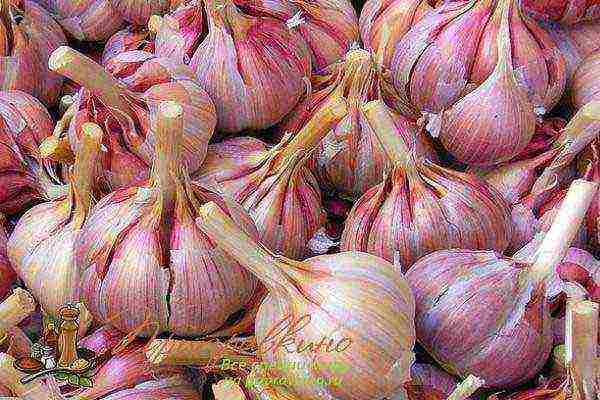
Otradnensky is a mid-late variety - it takes 95-135 days from germination to drying of leaves, universal purpose. The yield is very high - 12-13.5 kg per 10 m2. Bulbs over 30 g, round-flat, each with up to eight cloves. The variety is very winter hardy. Good for growing in the Primorsky Territory and Mordovia.

Sail - a variety of medium ripening - time from germination to harvest: 96-108 days. Yields a yield of 6 to 10 kg from 10 m2. Bulbs weighing 30–47 g, round-flat, dense, well stored, they contain 7–10 cloves. The taste is spicy. The variety is winter-hardy. Recommended for growing in the Voronezh and Nizhny Novgorod regions, in the Ukraine, in the Stavropol Territory and Kazakhstan.
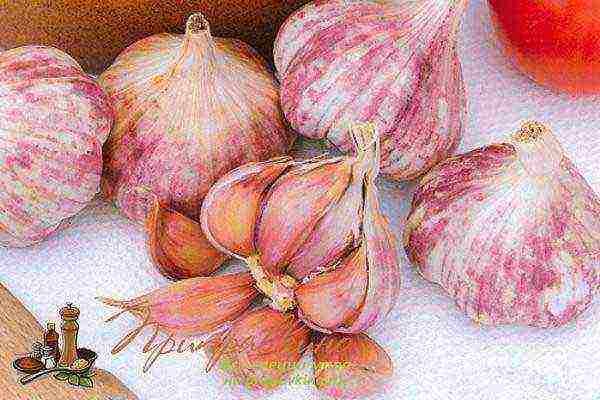
Siberian - medium term - from germination to harvesting 81-113 days, universal. Yields on average 5.8 kg per 10 m2. Bulbs weighing 20-30 g, round-flat, with medium-sized cloves (4-5 pcs.). The taste is spicy and semi-sharp. Suitable for growing in Novosibirsk, Kemerovo, Omsk and Tomsk regions.

Non-Shotgun
Novosibirsk - a variety of medium early ripening - 68–82 days pass from germination to harvesting, it is universal. Productivity 5-6 kg per 10 m2. Bulbs weighing up to 30 g, round, well stored. There are 9-13 cloves in the onion. The taste is semi-sharp, delicate. Recommended for Novosibirsk and Kemerovo regions.
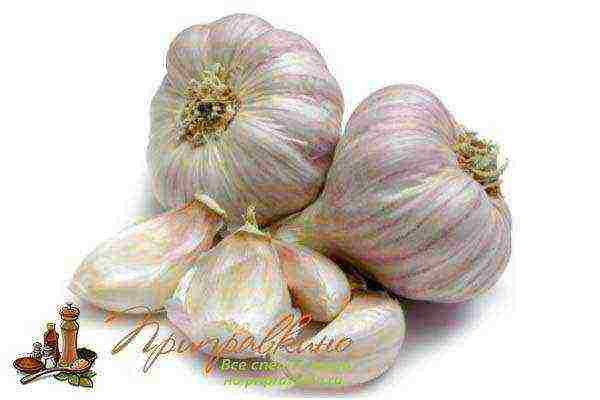
Saki is an early variety - it takes 100-115 days from germination to yellowing of leaves, universal use. Yield 4,2 kg per 10 m2 Bulbs weighing 20 g, flat and round-flat, with wide cone-shaped cloves. There are 11-13 of them in the onion. The taste is spicy. Well suited for growing in Crimea.

Garlic varieties for planting in spring
Among the spring varieties, a particularly large role belongs to the numerous local forms, which are usually very well preserved. Among them:
- Danilovsky (variety of the Yaroslavl region).
- Bryansk, Ufimsky (varieties of Bashkortostan).
- Cheboksary (grade of Chuvashia), etc.
Garlic varieties quickly degenerate, so they need to be changed periodically.
What soil is needed for garlic
Garlic grows well on fertile loose light sandy loam or loamy soil, in non-flooded areas, with sufficient sunlight; tree-shaded areas are not suitable for this crop. It does not tolerate either excessive moisture or prolonged drying out of the soil.
It is good if the bed is located on a sunny hillock and is protected from the wind by a fence, trees or shrubs. In spring, water should not stagnate there.
Before planting, the soil is dug up, loosened, the roots of perennial weeds are selected and carefully leveled.
When digging, humus (1-2 buckets) and wood ash (2-4 kg) are added per 1 m2. Instead of ash, you can take superphosphate and potassium salt (15-20 g each).
The acidic soil is limed. The garden bed is prepared two weeks before planting, as it should settle a little so that the garlic cloves do not go deep into the ground.
What to soak garlic before planting
Before planting, the garlic is treated with a weak solution of trace elements (one tablet is dissolved in 1 liter of water) or infusion of birch wood ash: 1 tablespoon of ash is thoroughly stirred in 1 liter of hot water and the garlic is soaked overnight.
To avoid the most common disease of garlic - downy mildew, the cloves are heated for 12 hours at 40 C before planting and treated with a 1% solution of Bordeaux liquid.
Growing garlic outdoors
The bulbs and chives in winter garlic are larger and more productive than in spring garlic, but the latter, due to the many scales, is stored longer. Better to grow both forms outdoors.
When and how to plant winter garlic
Chives of winter garlic are planted before winter after harvesting vegetables
cultures.The largest and healthiest bulbs are chosen for planting - without a single spot. Small teeth are discarded, only large ones are planted. It is very important to do it on time.
- In central Russia, planting dates are usually recommended from September 15–20 to October 5, a few weeks before the onset of stable November cold weather.
- Winter garlic is planted in the central regions of the Non-Black Earth Zone in the third decade of September.
- In the Moscow region, the best planting time is from September 25 to October 5.
- In the northern regions, the dates are moved to earlier ones, in the southern regions - to later ones.
Such planting dates are due to the fact that the cloves must take root well before the onset of stable winter cold weather.
Following such advice, amateur vegetable growers are often mistaken if, in late September - early October, after cold weather, a relatively warm weather suddenly sets in. And then not only the roots, but also the shoots begin to grow actively, and the subsequent November frosts destroy them.
With a delay in planting, the teeth do not have time to take root until the end of October and hibernate poorly. In the spring, such seedlings are sparse and frail at best. To avoid mistakes, it is advisable to know a long-term and reliable weather forecast.
Planting scheme for winter garlic
Teeth of the same size are planted in two lines. The landing pattern is as follows:
- the distance between the rows is at least 20 cm;
- between cloves in a row - 8–10 cm;
Planting depth depends on the type of soil: on light soils, it is 8-10 cm from the top of the clove to the soil surface, on heavy soils - 5-6 cm. Shallow planting of garlic can lead to the fact that when the temperature drops to minus 15 C, a significant part of the plants may die.
Each square meter requires 50 cloves, or 300 g of garlic (6-7 heads).
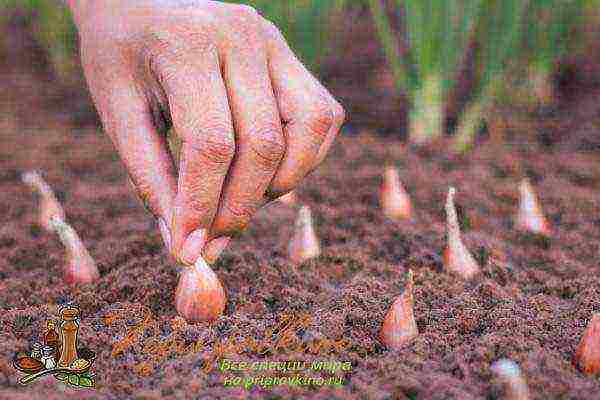
Although garlic is a cold-resistant crop, in November-December, the snow "coat" is still too unreliable and thin, so it is better to insulate the garden bed by sprinkling it with peat, well-rotted manure or loose compost soil with a layer of 2 cm.
Such mulching will do a good job in early spring, as the soil will warm up faster. In addition, mulch will keep the soil surface from crusting and help retain the moisture that garlic needs. As a result, this technique alone noticeably stimulates the development of young plants, increasing the yield by 10-15%.
How to grow winter garlic from bulbs (air bulbs)
Usually, air bulbs are used to obtain planting material - sevka. One or two days before harvesting the garlic, the arrows are cut off, leaving 2–3 cm above the bulb, tied in sheaves and left under a canopy for 25–30 days.
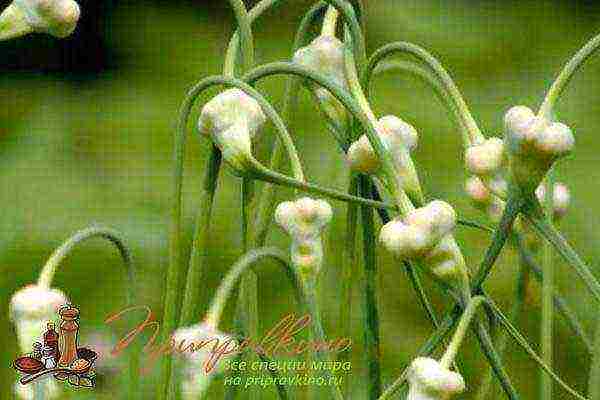
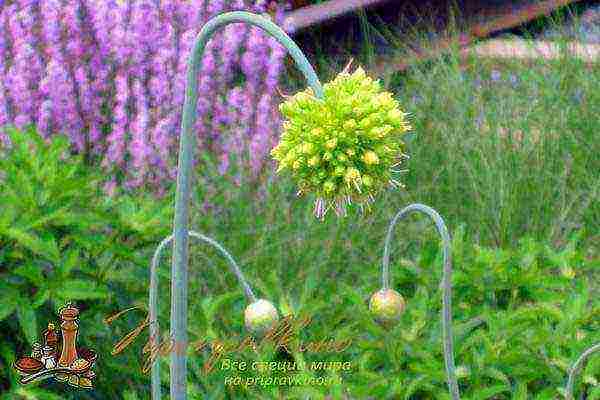
If you plant bulbs before winter, next year they will give single-tooth bulbs (sets), which will be the planting material.
Before sowing the bulbs - air bulbs are separated from the arrows by shaking, then calibrated. The smallest ones (less than 2 mm in diameter) are not suitable for sowing, as they produce very small single-toothed bulbs. It will take three years to grow bulbs from them, which can be divided into cloves.
Bulbs are sown in the third decade of September, like chives, on the ridges with lines, between which a distance of 10-15 cm is left. 8-10 g of bulbs are sown on one square meter of the ridge to a depth of 3-4 cm. Crops are mulched with peat or humus layer 2 cm.
The next year after the emergence of seedlings, the plants are fed with nitrogen and potassium fertilizers: 10-15 g of ammonium nitrate and 5 g of potassium salt per 1 m2. The crops are watered, the aisles are shallowly loosened, the weeds must be removed.
When the leaves turn yellow and dry, the plants are dug in, the one-toothed bulbs are selected from the soil, dried and prepared for autumn planting.
Plant one-toothed onion sets in the same way as chives. In the second year, normal arrowhead plants and bulbs are obtained, dividing into cloves.
Growing garlic from bulbs (how to rejuvenate garlic) - video
Aerial bulbs can also be sown in spring. To do this, they are stored in a cold (2–5 ° C) or warm (18–20 ° C) room in unmilled sheaves. This way they are better preserved. Early spring sowing of air bulbs after cold storage is almost the same as for winter sowing.
After storage in warm (18–20 ° C) and early spring sowing, well-developed plants grow: their growing season is longer than that of plants under winter sowing and cold storage. They give large sets, but later ripening.
If you didn't have time to sow garlic in early spring, you can do it in June. In this case, the plants do not form a bulb and continue to grow until the onset of winter. After overwintering in the soil, the next year they grow and develop in the same way as the arrowhead garlic plants grown from the cloves, but produce a smaller bulb.
How to plant spring garlic in spring
Two to three weeks before planting spring garlic in the open ground in the spring, the storage temperature of the planting material is reduced from 18-20 to 2 C. Immediately before planting, the heads are divided into cloves and the largest of them are selected.
After preparing the soil, it is carefully leveled with a rake, longitudinal grooves are made, the distance between their centers is 20 cm, between the cloves - 5-6 cm.
Planting depth 2-3 cm. The teeth should be planted in the center of the groove, bottom down. Seedlings begin to appear in 13-15 days.
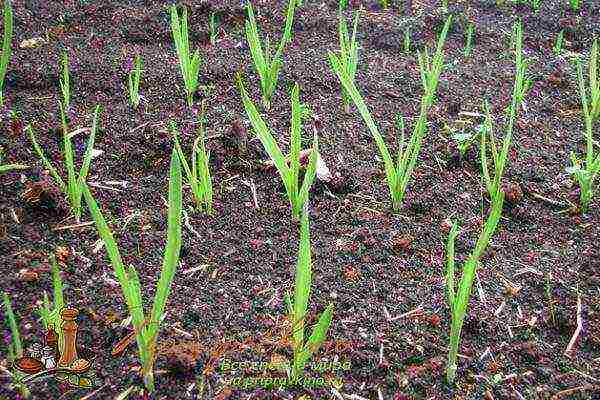
Outdoor garlic care
Caring for garlic plants consists in systematic loosening to a shallow depth (4-5 cm) so as not to damage the root system, in killing weeds, watering and feeding.
How to water garlic
During the period of active growth of garlic plants, the soil should always be moist. The lack of a sufficient amount of moisture reduces the yield, reduces the number of cloves in the bulbs.
Spring garlic is more moisture-loving than winter garlic and needs watering. Watering is necessary until mid-June. But garlic also does not tolerate waterlogging of the soil.
How and what to feed garlic after winter so that it does not turn yellow
The leaves of winter garlic begin to grow very early, when the snow has not yet melted everywhere. However, gardeners often see pale yellow and frail ones instead of bright green young shoots. The reason lies in insufficient plant nutrition. So that the garlic planted before winter does not turn yellow, in the spring water your plantings with a solution of ammonium nitrate (dissolve the fertilizer matchbox in a bucket of water).
Do the second feeding around mid-May. At this time, it is customary to feed the plants with a mixture of mineral fertilizers: ammonium nitrate, superphosphate and potassium salt (10, 20 and 10 g per 1 m2, respectively).
How to water the garlic in spring so that it does not turn so yellow if you want to do without the "chemistry"? In this case, it is better to use organic fertilizers for fertilizing, for example, a weekly infusion of fresh chicken manure (compared to mullein, it contains more nitrogen).
If the plantings dry up, water the soil abundantly, starting from the third decade of May and throughout June. The earth is periodically loosened with a hoe, I weed the weeds, preventing their regrowth.
The last, third, time they feed the garlic at the end of June, when the bulbs are finally formed. Summer nutrition is an infusion of mullein (1 liter of fertilizer is diluted in a bucket of water) or infusion of weeds growing on a compost heap in the same concentration. You can limit yourself to feeding with superphosphate (5 tablespoons per 10 liters of water). Since this fertilizer is poorly soluble in water, it is preliminarily boiled for 30 minutes in a mug of water, stirring often.
How and what to feed spring garlic
Spring garlic shoots begin to appear 13-15 days after planting. With mass seedlings, the soil surface must be loosened and fertilized with nitrogen fertilizer. To do this, 15 g of ammonium nitrate is dissolved in 10 liters of water and evenly poured into the grooves at the rate of 10 liters per 1 m2.When the liquid is absorbed, the grooves are closed with dry soil.
The second feeding with nitrogen and potassium (potassium chloride) fertilizers should be given in the phase of formation of four leaves at the rate of 20 g per 10 l of water.
The third top dressing - potassium and phosphorus (superphosphate) fertilizers - in the phase of the seventh leaf - at the rate of 20 g per 10 l of water, solution consumption 10 l per 1 m2. After each feeding, the garlic is watered.
Tips on how to grow large heads of garlic
Around the twentieth of June, garlic throws out flower arrows, at the end of which airy bulbs (bulbs) develop. A few of the most powerful arrows that appear first can be left for seeds. The rest are gradually removed at the stage of formation, when they are good as vitamin greens for salads and canning.

Timely breaking the arrows at the very base, from the leaf axils, increases yield and allows you to grow large garlic.
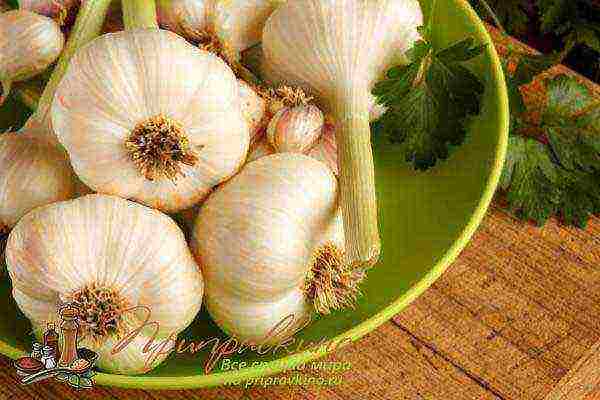
Do I need to tie the garlic after breaking the arrows? Tying the garlic arrows in a knot, practiced by some growers, does nothing, since the development of the arrows does not stop, and a good half of the nutrients do not enter the bulb.
Harvesting and storing the harvest of garlic
Stop watering the garlic a few weeks before harvest. To determine if the garlic is ready to harvest, inspect several bulbs by thoroughly cleaning the dirt.
When to dig out garlic planted in the winter
A sign of the ripening of garlic is the cessation of the formation of new leaves. In non-shooting varieties, the leaves turn yellow, in those with arrows, the caps on the bulbs crack, dense wrappers form on the bulbs, the head becomes ribbed.
As soon as the leaves begin to turn yellow and dry, it means that the garlic is ripe. Now it is impossible to hesitate with cleaning - if there is a delay, the teeth break the wrapper and crumble, such heads will be unsuitable for long-term storage.
Garlic is harvested in dry weather. Ripe bulbs are dug out with a pitchfork, carefully picked out of the soil and laid out in rows for several days to dry in the sun.
Then the roots and stem are cut with pruning shears, leaving about 1.5 cm. If the stem is shorter, the hard scales of the cloves can be damaged, and then the garlic will be poorly stored.
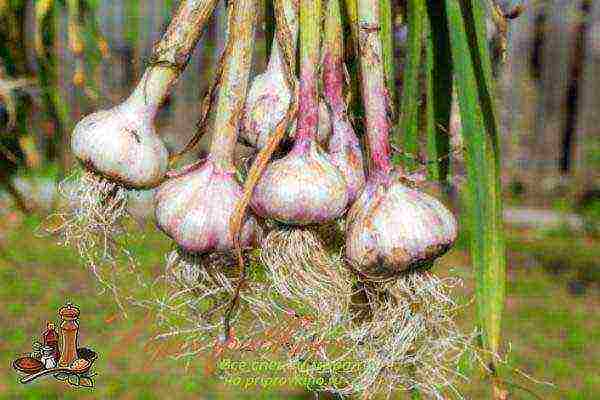
When to harvest spring garlic
Depending on the variety and weather conditions, spring garlic ripens at the end of August or September. The main signs of ripeness:
- lodging of tops;
- drying of the lower leaves;
- yellowing of the upper leaves;
- dying off of roots (they become thin, dark).
Choose dry weather for cleaning. It is impossible to delay harvesting, as in rainy weather the garlic forms new roots and germinates. The bulbs are dug in with a shovel or pitchfork and picked from the soil. Dry them in the air or indoors until the leaves are completely dry.
Then the bulbs are cleaned of the remnants of the adhered earth, the roots and the false stem are cut off 4–5 cm above the shoulders. After that, the garlic is finally dried (it should rustle during tedding) and put into storage.
How to store garlic in the winter at home to keep it dry
It is better to process the main part of the crop immediately and make preparations for the winter. The rest is stored until spring in a room where in winter the temperature is rather low, but positive, with low air humidity. The prepared heads are placed in boxes, baskets or mesh bags, they can be woven into braids.

At a temperature of 1-3 C, they will remain juicy and fresh for a long time, and until spring they will not germinate or dry out.
Experienced growers know how to properly store garlic at home at room temperature. There are two reliable methods suitable for a city apartment:
- Well-dried heads of garlic are folded into a canvas bag, tied and put into a plastic bag, leaving it open.
- Another method - you need to take a jar or a saucepan, pour a 2-3 cm layer of salt on the bottom, then put the heads of garlic and add salt again, etc. The top row must be covered with salt, but it must not be wet.
What can be planted after garlic next year
Garlic can be returned to its original place only after four to five years. As an exception, this is possible, but only if an infection has not accumulated in the soil during the first year of cultivation, which is easy to check if you carefully examine the heads of garlic grown there. If he is completely healthy, without the slightest signs of any lesions, you can take a chance and plant garlic in the same place for the next year, but not more.
It is undesirable to plant onions after garlic, since these crops are affected by the same diseases.
Here's what you can plant after garlic:
- cucumbers;
- zucchini;
- pumpkin;
- early harvested root vegetables and early cabbage;
- all legumes and greens.


